August 8, 2025
Air Date: August 8, 2025
FULL SHOW
SEGMENTS

Complex Air Pollution and Public Health
View the page for this story
Thousands of people across the United States live near multiple industrial facilities and petrochemical plants that expose them to higher levels of air pollution, but chemical exposure risk is commonly regulated one chemical at a time. A study conducted by a group of Johns Hopkins researchers found that “fence line” residents are at higher risk for multiple health problems because of the toxic mix of air they breathe. Lead author Dr. Keeve Nachman joined Host Paloma Beltran to walk through the study. (10:16)
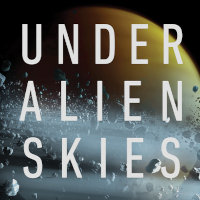
Under Alien Skies: A Sightseer's Guide to the Universe
View the page for this story
Astronomer Philip Plait wondered what it would be like to walk on Mars, fall into a black hole, or fly through a nebula, so he wrote a book, Under Alien Skies: A Sightseer’s Guide to the Universe. He joins Host Aynsley O’Neill to reveal the strange colors of a sunset on Mars, what it’s like on a planet orbiting binary stars, the unique challenges of landing on an asteroid, and more. (21:25)
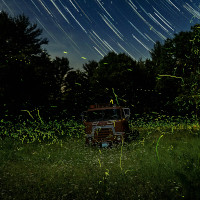
Fireflies at Risk
View the page for this story
The summertime magic of fireflies lighting up at dusk is facing threats because of climate change and habitat destruction. Living on Earth’s Ashanti Mclean shares with Hosts Aynsley O’Neill and Paloma Beltran a few tips that can help to protect firefly species. (03:04)
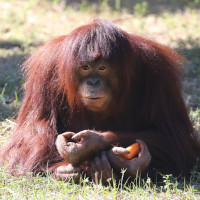
Animal Self-Medication
View the page for this story
A paper published in the journal Scientific Reports describes the case study of an orangutan who treated and healed his own wound. Zoologists have long seen behaviors of self-medicating in the animal kingdom, but until now it has rarely if ever been documented in scientific literature. Michael Huffman, an ecologist who reviewed the paper joined Host Paloma Beltran to discuss how some animals are known heal themselves. (12:16)
Show Credits and Funders
Show Transcript
250808 Transcript
HOSTS: Aynsley O’Neill and Paloma Beltran
GUESTS: Keeve Nachman, Philip Plait, Michael Huffman
REPORTERS: Ashanti Mclean
[THEME]
O’NEILL: From PRX, this is Living on Earth
[THEME]
O’NEILL: I'm Aynsley O’Neill
BELTRAN: And I’m Paloma Beltran. A group of scientists use a mobile laboratory to study cumulative air pollution in Pennsylvania’s fenceline communities.
NACHMAN: There is nowhere in our country or anywhere in the world where people are exposed to a single chemical at a time. And our long-standing approach of trying to regulate them on a one-by-one basis is missing the boat and under-protecting people.
O’NEILL: And if you like science fiction, science fact can be even more amazing.
PLAIT: We all remember Luke Skywalker standing at sunset on Tatooine, with his leg on the rock and the wind whistling through his hair as these two suns set on the horizon. That’s an iconic scene. But it’s also kind of correct! They kinda got that right!
O’NEILL: That and more, this week on Living on Earth. Stick around!
[THEME]
Complex Air Pollution and Public Health

A Chester, Pennsylvania neighborhood sits adjacent to the ReWorld Delaware Valley facility, formerly known as the Covanta facility, during the time of the study. The Delaware Valley Resource Recovery facility (DVRRF) is a permitted waste-to-energy facility. The study showed that fence line communities are at a higher risk from air pollution than previously understood. (Photo: Peter DeCarlo)
O’NEILL: From PRX and the Jennifer and Ted Stanley Studios at the University of Massachusetts, Boston, this is an encore edition of Living on Earth. I’m Aynsley O’Neill.
BELTRAN: And I’m Paloma Beltran.
BELTRAN: Scores of Americans live near petrochemical plants and other industrial facilities that constantly release chemicals into the environment. Historically, the risk of chemical exposure to those residents has been examined one chemical at a time. But according to a group of Johns Hopkins University researchers, that approach fails to accurately ascertain the overall air pollution and health risks to people who live near those industrial sites. So, using what’s called a mobile laboratory, or lab on wheels, that team of researchers drove around petrochemical facilities in Chester, Pennsylvania, for about a month, measuring chemicals in the air at all hours of the day and night. Their study found that fenceline residents are at higher risk for harmful air pollution because of the toxic mix of air they breathe. The research was also submitted into the record as part of a Pennsylvania bill that requires the state permitting process to look at cumulative impacts. Dr. Keeve Nachman is the Robert S. Lawrence Professor of Environmental Health and Engineering at Johns Hopkins University. He led the study and joins us now to explain more. Dr. Nachman, Welcome to Living on Earth!
NACHMAN: Thanks so much for having me, Paloma.
BELTRAN: So, your team is using a new approach to measure air pollutant risk across fenceline communities. What method did you use? How did that look like?
NACHMAN: So, we have two exciting methods that I think make the work that we're doing so important. The first is that we are using cutting-edge mobile measurement technology. So, we essentially have a chemistry lab in a van or a small truck, and we're able to drive that truck around communities where we're trying to understand the impact of air pollution and measure toxic chemicals in real time and over space. And it allows us to develop these highly confident estimates of air pollutant concentrations that we then translate into some estimate of how likely people are to get sick if they were to breathe air like this over their lifetimes. So that's the first interesting piece, is that we have really great air measurement data, and then the other piece of what we've done that's so neat is we've taken this new approach to trying to translate information about what people breathe into some sort of characterization of how likely they are to get sick, if what we measured reflects what they breathe over a lifetime.
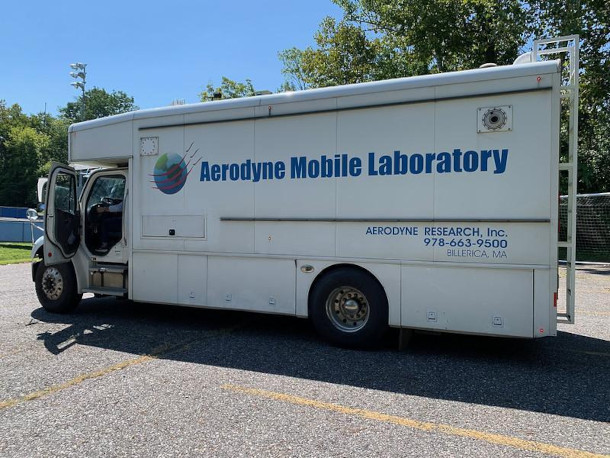
The Aerodyne Mobile Laboratory that the Johns Hopkins University team used to conduct research in Chester and other southeastern Pennsylvania towns. (Photo: Peter DeCarlo)
BELTRAN: How does your research compare to the traditional approach of measuring chemicals?
NACHMAN: So, our research changes the way we interpret information about concentrations of chemicals that people are exposed to. We developed a novel approach to characterizing the impact of chemicals that is more holistic than the traditional regulatory approach to interpreting information about people's exposures when they breathe polluted air. And what's really important about our approach is that our approach recognizes that each of the chemicals in the mixture can target multiple parts of the body, and it doesn't ignore the less sensitive parts of the body that each chemical affects. And so, when we take all that information together, we may find evidence of risks that the traditional methods may miss. And so, in particular, when you use the traditional regulatory risk assessment approach with the air pollution data that we developed in Pennsylvania, you actually don't find that any of the organ systems in the body would be at an elevated risk. And so, as a result of that, you may conclude that the air pollution exposures that people in that community incur are not a problem, and if you believe that they aren't a problem, there's very little motivation to do anything to change people's situations, right?
So, our method, because it does more than just account for one effect per chemical. It accounts for the fact that each chemical could elicit multiple effects in the body, we come to different conclusions. So, we actually find for five different parts of the body an elevated risk that people breathing that air may experience five different non-cancer health outcomes, including respiratory effects and two others, and those effects would be entirely missed using the traditional regulatory approach. And the reason why that's so important is that the interpretation of our results would likely lead to very different approaches to managing risks in the community. We find that, given current conditions, it's reasonable to expect that people would get sick with one of those five diseases or ailments or affected organ systems. And as a result, if posed the question of whether it would be okay to permit an additional industrial facility in the region, I would think we would likely determine: no, the community is already overburdened, given what we're able to estimate now. And again, that's different from what you might conclude given a traditional risk assessment, where we might say “there's no reason to think that the conditions that people are currently experiencing are problematic. So go ahead.”
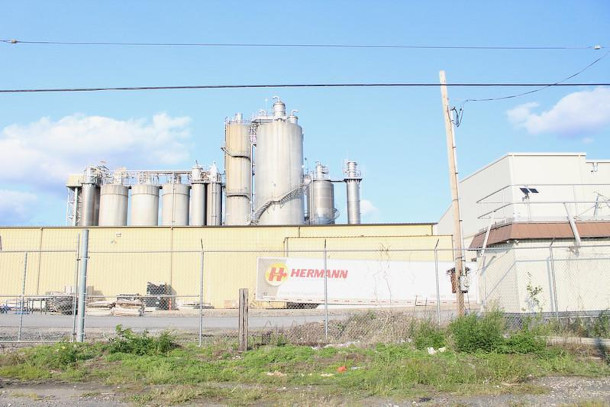
The team tested the air around industrial plants such as the Evonik facility in Chester, with the Pennsylvania Department of Environmental Protection measurement site in the lower right of the photo. According to the EPA's Toxic Release Inventory, the Evonik facility's production includes ammonia, sulphuric acid, sodium hydroxide and sodium sulphate. (Photo: Peter DeCarlo)
BELTRAN: How can this approach be applied to other fenceline communities across the United States?
NACHMAN: The method we developed for this study has implications far beyond the community in southern Delaware County and Pennsylvania. I'm thrilled that we were able to use it to help characterize the risks that they may be facing. That's really, really important and a big part of our collaboration with them, but this approach can be applied anywhere. So certainly, it has value in other communities living on the fenceline. Cancer Alley in Louisiana is certainly a place where there's heavy petrochemical and other industrial processing that may be impacting the lives and the health of people who live in those communities, and I think it would be readily deployable there our method, but I think this method really even beyond fenceline communities and even beyond air pollution, has relevance. There is nowhere in our country or anywhere in the world where people are exposed to a single chemical at a time, and our long-standing approach of trying to regulate them on a one-by-one basis is missing the boat and under-protecting people.
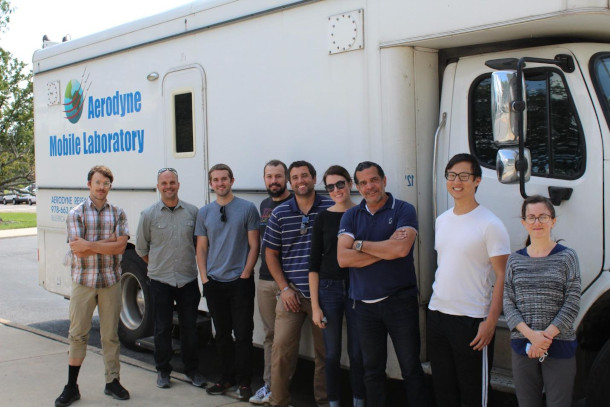
Scientists from Aerodyne Research and Johns Hopkins University drove the mobile laboratory all hours of the day and night to measure the pollution experienced by residents who live near industrial facilities in Delaware County, Pennsylvania. From left to right: Ellis Robinson (JHU), Peter DeCarlo (JHU), Conner Daube (AR), Ben Werden(AR), Joseph R. Rosciolli (AR), Kenji Lizardo (AR), Megan Claflin (AR), Roger Sheu and Mina Tehrani (JHU). (Photo: Peter DeCarlo)
And so we are excited to use this method elsewhere, to use nuance and a fuller understanding of the negative action of each chemicals to characterize the risks that people face, and in the immediate future, we're looking at taking this method and using it, not only for air, but looking at a community where we can get data on air, on drinking water, on soil exposures, on consumer products, on food, and taking those exposures together and saying something about what that collective experience means for health. And really, that's the truest essence, or that's a major step towards this idea of cumulative risk assessment. Looking at mixtures is just one piece of it. You know, mixtures are very important, but we also recognize that chemicals are not the only stressor people experience in their lives, and we often know that fenceline communities are experiencing other forms of disadvantage that may make them more vulnerable to chemical exposures. So, if we aren't accounting for all of those other stressors, and we're making decisions in the absence of that consideration, we aren't protecting people the way we should and the way they deserve.
BELTRAN: You know, Keeve, your study was published at a time when the Trump administration is cutting and limiting environmental justice programs across the country. What impact could this research have on policy-making, especially regarding rules to protect our most vulnerable populations? What are you hoping to see here?
NACHMAN: I have to acknowledge that this is a time when many of us are feeling discouraged about work like this being used in the immediate future to intervene on injustices faced by fenceline communities around the country. That said, this work and the approaches here and a lot of the work that many of my colleagues are doing in the field, hold a lot of promise and represent important advances towards true characterization of the combined or cumulative burdens that communities are facing. And I think now is a time to develop these methods and to really hunker down and generate the evidence we need to use as a basis for smarter policy making when windows open up in the future where there is receptivity to making better decisions. I'm confident that those windows will reopen, even if, in the short term, we feel like they're closed. So, I haven't lost hope, and we're moving ahead with our research and with deploying these methods, because we know the time will come where there will be receptivity to using them, and change will happen, and we will do a better job of protecting the health of the public.
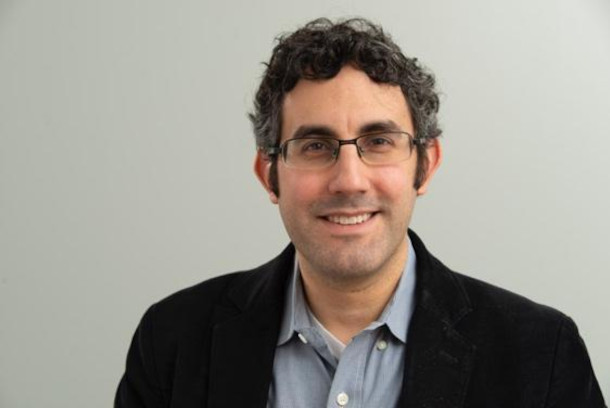
Keeve Nachman, Robert S. Lawrence Professor of Environmental Health and Engineering at Johns Hopkins University, analyzed the data from the testing conducted by his colleague Peter DeCarlo and the team of Johns Hopkins University and Aerodyne Research scientists. (Photo: Courtesy of Keeve Nachman)
BELTRAN: What lessons do you hope residents of other fenceline communities learn from this study?
NACHMAN: The only thing I really hope that residents of fenceline communities take away from this is that we're working hard to develop the data that we can use to protect them. I want to be really clear, and I'm asked this by reporters a lot, what can residents do differently? I don't think the burden should be on residents to do anything differently. I think residents are the ones who are bearing the brunt of the decisions of other actors, like the industry and federal, state, and local governments. They're the ones that should be doing things differently to protect residents. Residents should feel free to live their lives as—as they want. And so, I bristle a little bit at the notion that there's anything anyone can do other than know that we are not losing sight of the prize of public health protections for all U.S. citizens and beyond.
BELTRAN: Keeve Nachman is the Robert S Lawrence Professor of Environmental Health and Engineering and Associate Director of the Center for a Livable Future at Johns Hopkins University. Thank you for joining us!
NACHMAN: Thanks so much for having me.
Related links:
- Read this study in Environmental Health Perspectives
- Washington Post | “Breathing Dirty Air Is Worse for Your Health Than We Thought”
- Franklin County Press | “Pennsylvania Bill Aims to Address Cumulative Environmental Impact in Permitting Process”
[MUSIC: Jamie Laval & Ashley Broder, “Staircase” on Zephyr in the Confetti Factory, by Ashley]
BELTRAN: Coming up, what the universe outside our planet is really like. That’s just ahead on Living on Earth. Stay with us!
ANNOUNCER: Support for Living on Earth comes from the Waverley Street Foundation, working to cultivate a healing planet with community-led programs for better food, healthy farmlands, and smarter building, energy, and businesses.
[MUSIC: Vanderlei Pereira and Blindfold Test, “Les Matins de Rixensart (The Mornings of Rixensart)” on Vision for Rhythm, by Vanderlei Pereira, Jazzheads Records]
Under Alien Skies: A Sightseer's Guide to the Universe

Philip Plait’s 2023 book, Under Alien Skies: A Sightseer’s Guide to the Universe, explains what it would be like to explore outer space. (Photo: W. W. Norton)
BELTRAN: It’s Living on Earth, I am Paloma Beltran
O’NEILL: And I am Aynsley O’Neill
From Star Trek to Star Wars to Treasure Planet, fictional portrayals of outer space are everywhere. But if you’re wondering what walking on Mars, flying through a nebula, or falling into a black hole would actually be like… that’s better left to science fact than science fiction. Luckily, one astronomer has written a book all about these strange realities. Under Alien Skies: A Sightseer’s Guide to the Universe takes readers on a cosmic journey while teaching them what the universe outside our little blue planet is really like. Joining us now is author Philip Plait, former member of NASA’s Hubble Telescope team and writer of the newsletter called Bad Astronomy. Phil, welcome to Living on Earth!
PLAIT: Thank you. It's nice to... well, it's nice to live on Earth. So, thanks.
O'NEILL: So, Phil, Under Alien Skies has these really engaging descriptions that sort of imagine what it would be like to travel to various places in outer space. Could you please read from the first two paragraphs or so from the chapter on Mars?
PLAIT: Yeah, sure. I'd be happy to. “You're out of bed early, suited up, and out the airlock before anyone else is awake. It's not strictly protocol. The commander says you should have a buddy with you when out on the surface when possible. But you love seeing the landscape as the sun rises. You walk out a ways from the hab module until the view to the east is clear. Facing west first, though, you watch as the black sky above you turns butterscotch in a slow wave moving down toward the horizon. As you turn to face east, the sun appears, and the sky around it turns a shade of pale blue. Even so, there are still stars visible. The thin air doesn't scatter enough light to entirely block them, even when the sun is up. One stands out though, a blue green jewel shining a few degrees above the sun. That's home you think, Earth some 50 million miles sunward.”
O'NEILL: And now these sections walk the line between non-fiction and sci-fi. What made you decide to incorporate little fictional scenes into this science book?
PLAIT: Oh, that's easy. I'm a dork.
O'NEILL: You're in good company.
PLAIT: Yeah, there are millions of us. For me, science and science fiction are both ways that we describe reality. And in science fiction, we use our imagination, right? We have science that we don't necessarily have yet, whereas in actual science, we're using our imagination to try to imagine what these things are like that we're describing. You know, in astronomy, you've got some planet that we've discovered, and it's orbiting some star, and we know enough about the star and where the planet is to start guessing intelligently about what conditions would be like there. And by using our imagination, we can fill in some of those gaps. And the beauty of that in science is it gives you an idea of what you might want to look into next. Like, I wonder if liquid water could exist on this planet. Well, you know, it depends on the atmosphere. Well, what kind of atmosphere would it have? And so, it's all of this imagination going into it. So, for me to write a book about these places, starting each one off with a little science fiction vignette, an anecdote, that is me holding your hand and showing you all of these amazing places that astronomers, we live our lives in. We just can't actually go there typically.
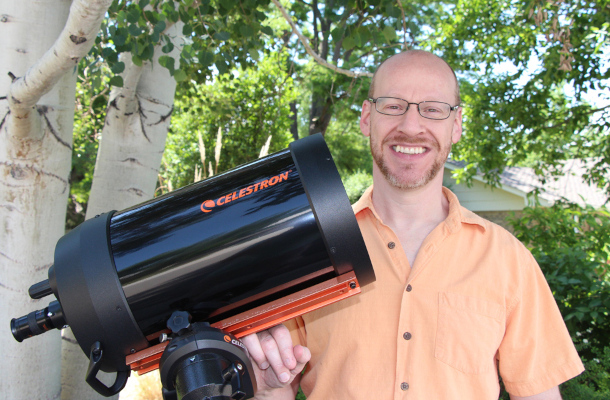
Phil Plait is also the author of Death from the Skies and Bad Astronomy. (Photo: Marcella Setter)
O'NEILL: Well, one aspect that I really enjoy is that you incorporate, of course, the science fiction, the science fact, but you also go into the history of astronomy. You talk about how we found out what we know now. Tell us a little bit more about the history of astronomy that you put into this book.
PLAIT: That was another easy decision because something that really bugs me about the way people think of science is they think of it as like a compendium of facts. It is a dictionary that you open up to what our star is made of, and you look it up, and it's, oh, hydrogen, helium, blah, blah, blah. And how do you know that? You read it in a book, but how do you know the book's right? So, by throwing in the history of how we learn some of this stuff, it makes it more like what science really is, and that is a process. Science is not something you look up. It is something that learns and grows, and it's almost like its own organism. It's almost like a living thing. Science doesn't just grow linearly. It's not just “we learn this, then we learn this, and then we learn that.” It's not like that. And so, it's kind of fun to put stuff in the book that says, you know, hey, this was a matter of some debate, and then it turns out this person was right, or they were both wrong, or something like that. It makes it more human. I talk about how the first planets around other stars were discovered. It's one of my favorite stories in all of science. Basically, some scientists had announced that they had found a planet orbiting another star, and then turns out they were wrong. They had made a mistake in the way they observed their data. And they had to stand up in front of a group of their peers and say “We messed up”. And then the next team of scientists walks up to the microphone and said, Yeah, we actually have discovered a planet. We didn't do the same thing they did, and our data are good. And yeah, they were right.
O'NEILL: Wow.
PLAIT: Literally, the next people to talk at that conference. You know, you couldn't write that in a TV show, but it really happened. And so, I just, I love it. I just love stuff like that.
O'NEILL: And one of the amazing facts that we learned via that scientific process is that Mars has a sort of color-flipped version of Earth's sky. So, during the day, the Martian sky is a sort of orangey red, but then it turns blue at sunrise and sunset. Why is that the way it is?
PLAIT: Right, it's the opposite of Earth. During the day, our sky is blue, and then when the sun sets, the sun kind of turns red, and the sky around it turns red. And for us here, it just has to do with the way Earth's atmosphere scatters blue light. So red light can just pass right through our atmosphere, but the blue light from the Sun bounces off these molecules in our atmosphere and then can come at you at any random direction. So anywhere you look in the sky, you see blue, but you only see red when you're looking toward the sun. On Mars, it's the opposite. Mars has all of this dust in the atmosphere that is heavily laden with rust. It's iron oxide, different kinds of iron oxide, but it's rust. And so, you know, you know what the color of rust looks like. It's that orangey hue. And so, during the day, the sunlight passing through Mars's atmosphere is lighting this dust up. And so, it looks orange. However, near the Sun, there is another effect that takes place, and it has to do with the way light is scattered. But that blue light is scattered toward you. And so, when you are looking near the sun, the sky looks blue. I mean, even during the day, even at noon, but at sunset, that effect is magnified a lot. And so, the sunsets and the sunrises on Mars are going to look blue near the sun. So, it's the exact opposite of Earth, even though it has an atmosphere, and it's kind of Earth-like and all this stuff, you wind up getting the exact opposite thing that you might expect. It reminds you that Mars is an alien world.
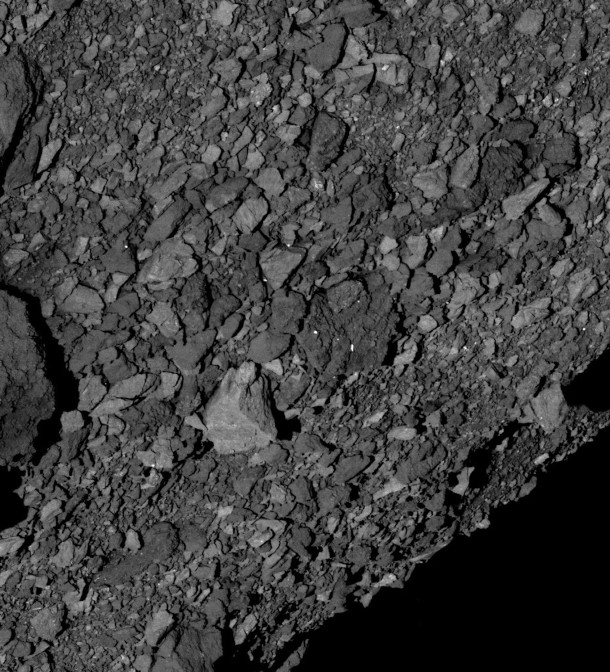
The chapter on asteroids was Plait’s favorite to write. Asteroids may look solid, but they are really just rubble piles held together by gravity. (Photo: NASA, public domain)
O'NEILL: And this book doesn't just cover places within our solar system. It also goes into detail about what it would be like to be outside of our little cosmic neighborhood, and it includes a section about a planet that orbits two suns. Tell me more about that chapter and about the idea of this binary star system.
PLAIT: Right, how could I not write about this? It's so cool. I mean, we all remember Luke Skywalker standing at sunset on Tatooine with his leg on the rock and the wind whistling through his hair as these two suns set on the horizon. That's an iconic scene, but it's also kind of correct. They kinda got that right. Tatooine orbits two stars that are both kind of like the sun, and it's on a, it's what's called a circum binary orbit, which means it goes around both stars. You can also have binary stars, two stars that orbit each other and have a planet only orbiting one of them, and the way the sky looks in these circumstances are different, especially if you orbit one star and the other one is orbiting much farther out. There are times of the year when it's always bright out. You've always got a star up in the sky. The star you're orbiting sets, but this other star farther out is still up in the sky, and it would be very bright, like brighter than the full moon, so you'd still be able to go out and do things at night. Other times of the year, when they're lined up and both in the sky near each other, they would set, and it's dark, just like it is on Earth. So, you'd have these really weird seasons where nighttime changes quite a bit. And if you orbit both, it's also very strange, because you have two stars in the sky, they'll cast two shadows, kind of, sort of. I exaggerated that a little bit for the book, that you would see two shadows. It's not that obvious. However, if these stars orbit each other very closely together, as they would have to, if you orbit both, sometimes one will pass in front of the other one. You'll have essentially an eclipse, except you're not blocking a star with the moon. You're blocking a star with another star. So instead of two stars in your sky, now you have one, and the temperatures will cool off very rapidly. And so, I had a lot of fun extrapolating what life would be like. What would it be like to live on a planet where sometimes it doesn't get dark at night and other times it gets very cold suddenly for an hour or so during the day, even in the middle of summer. It was very strange to think about this stuff, but a lot of fun.
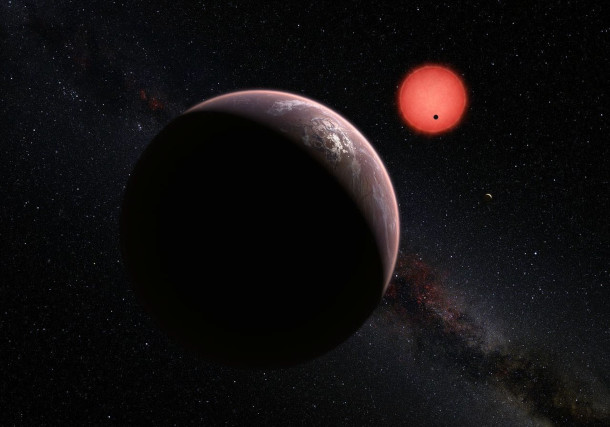
TRAPPIST-1 is a planet that orbits a star other than our own sun. (Photo: NASA, public domain)
O'NEILL: Now, when the book is describing places outside our solar system, it does talk about how we may never travel to these distant locations, because it is, as far as we know, probably impossible to travel faster than the speed of light. What does this mean for the future of space exploration? And also, what does it mean for the possibility of finding extraterrestrial life out there?
PLAIT: Well, that's a big question. I was very careful in the book to use as much current science as I could, and when I can't, I'm very clear about that. So, when we leave the solar system in the second half of the book, I make it clear. It's like, look, we don't have faster-than-light ships, but let's pretend we do, and we can just hop on board and travel to a globular cluster—a cluster with a million stars in it, and be on a planet that's orbiting one of these stars. But if we can't do that, what does that mean? Well, the search for life on other worlds isn't limited to us boarding the USS Enterprise and heading off into the deep black. We're looking in a lot of ways. We're listening for radio signals from intelligent life. We're looking for what astronomers called biosignatures, which are signs of, say, oxygen or water in the atmospheres of planets orbiting other stars. You don't have to go to these places to maybe find life. There are maybe, maybe, maybe ways of detecting it, even from Earth. And we don't know, because we haven't done that yet. We have a lot of really good ideas. I mean, that was just a couple. There are dozens of ways that astronomers are looking for life on other planets, but it would have to be passive. In other words, it would have to come to us, these signals, whether it's intelligence signals or the signal of oxygen in the atmosphere, for example. That's just how it is. Unless somebody figures out how to make a warp drive, we're not going there anytime soon. It would take 100 years to get to the nearest star, more or less. We understand that there is technology that could travel at a decent fraction of the speed of light. But even then, it's 40, 50, years just to get to the nearest star. That's a lifetime. You better be absolutely sure you know what you're doing when you close that hatch and head off. And right now, we're just not there yet.
O'NEILL: And so, Phil, you got to write about some really incredible places. Which chapter was your favorite to write?
PLAIT: Oh, you can't ask an author that. It's like asking a parent who their favorite kid is.
O’NEILL: I know.
PLAIT: But in fact, typically what I would say is Saturn. I love Saturn. Everybody loves Saturn. If you've ever seen Saturn through a telescope, it is just phenomenal. You can see those rings. You can see moons orbiting it. And a lot of astronomers, myself included, will tell you, I got hooked when I was a kid because I saw Saturn through a telescope. And I show people Saturn through a telescope, and it's just so much fun to watch their faces. This wave of awe comes over them. They gasp, they laugh, they shout. They can't believe that it's real. And so, writing about Saturn was amazing. And so that's the easy answer, and that's what I usually say. But I gotta say, writing about asteroids was a lot of fun. I'm fascinated by asteroids, these chunks of—of rock and metal that orbit the sun, most of them out between Mars and Jupiter, so pretty far from the earth. Most people think of asteroids as these giant rocks that can hit the earth, wipe out the dinosaurs, maybe give us a pretty bad day. But as scientific objects, these are the precursors of the planets. These were the building blocks that built up the planets, including Earth. And we didn't know that much about them when I was a kid, and I would watch TV shows, and there'd be a swarm of asteroids that would, you know, wipe out the ship or make them go off course, or whatever. And it turns out, it's not like that. There are millions of them out there, but they're spread way out. And they're not just like giant chunks of rock, like you'd expect, like a mountain. The smaller ones are actually like bundles of debris. They're like bags of rocks. We call them rubble piles. And it's like go to a construction site and see where they've dug up all the rocks out of the ground. It's kind of like that. They're just rocks held together by their own gravity. And it turns out it makes them pretty different. The rocks are so fragile on these things that if you picked one up, you could easily crush it with your hand. And so if you try to land on an asteroid, you could literally fall right through the surface and find yourself buried inside this thing. Be like jumping into a box filled with styrofoam peanuts. They just scatter everywhere, and you fall right in. That was so surprising to me, but we had a space probe that did that. It touched an asteroid, and if they hadn't backed it out of there, it would have sunk right in. And I think that surprised everybody.

Plait recommends looking at the sun to see sunspots, but only wearing appropriate eye protection like eclipse glasses. (Photo: Mamta Patel Nagaraja, NASA, public domain)
O'NEILL: So, reading this book, in some ways, provides a sort of escape from the problems here on Earth. I mean, especially with that second-person perspective, you really feel like you're out there on Pluto. But some might say that given issues like the climate crisis and conflict around the world, that we shouldn't prioritize space exploration and space science. How do you respond when people say things like that?
PLAIT: Well, I understand that attitude, but it's not looking at it the right way. It's an ill-posed question, as we like to say. First of all, it's not a dichotomy. It's not like we're spending all this money on space. We should be spending it on Earth. In fact, NASA's budget is so small, it's less than half a percent of the federal budget. As an astronomer once said, if you were to take the budget of the United States as a $1 bill, and you cut the edge off where NASA's budget is. You wouldn't even hit the ink. It's very, very, very tiny amounts. So, the amount we're spending on the military is vast compared to space exploration. So, I'm not saying we don't need a military, but we spend the money on a lot of things, and spending it on space exploration... really, there are much larger things you could turn to to say: why are we spending money on this? But also we're spending that money not in space. It's not like we're launching rockets full of $20 bills and letting them go. We're spending that money here on Earth, and we are learning about Earth. We have problems here. But how do you think we study climate change? If you're worried about climate change, you should be wanting to spend more money on space exploration, because we look at Mars, we look at Jupiter, we look at Venus, we study what the weather is going on there, and that informs us on how the weather works on Earth. It's a very, very complex set of systems, and by studying how it works on these other planets, it informs us on how it works here.
PLAIT: So Phil, you're obviously an expert on space, but I'm guessing you didn't know every single fact in this book before you wrote it. So, what was the research process like?
PLAIT: Yeah, I do have a passing familiarity with a lot of the topics in this book. Some of them, I've studied professionally. Other ones, I've written about a lot because I'm a science communicator. I've—I have a newsletter. I've written for a lot of magazines. And so, for some things, it was pretty easy to sit down and write them. For other things, there were just things I didn't know, so I had to go and look them up. And for a lot of them, I had a basic grip on the physics or what it would be like, but actually knowing the numbers. So, if I'm going to describe for example, well, how much does the temperature drop on a planet orbiting a binary star when one of the stars blocks the other one, and well, it turns out I did something similar to that in graduate school to get my PhD. I worked out some of the math for that, but doing it for this was different, and I had to back out of that equation that I remembered and actually derive it because it wasn't quite right for what I needed to do. So, I had to, like, dust off my brain from 30 years ago being in graduate school and go, Oh, yeah, how do we do this physics? And eventually got the right numbers. And so, the book doesn't have any math in it, but there's a lot of math that went into it, and I had to make up, oh my gosh, spreadsheets. And let me tell you something, I hate spreadsheets. That's how much I wanted to write this book. I hate doing spreadsheets. But to talk about, for example, TRAPPIST-1 is a star near Earth that has seven planets orbiting it, and they're all about the same size as Earth. And you can see them. Each planet, you can see the other six planets. But how big are they? How big do they get? And I had to write all of this math down and put it in a spreadsheet so that I had it in front of me, because it was complicated, I couldn't remember all these numbers. So yeah, there was a lot of reading, a lot of research. So, like any science book, there is a lot of research that goes into it that you never see, but it does inform the prose. So, it was a lot of fun to do all that.
O'NEILL: Well, you've got all this professional experience, and you've clearly got all this passion for learning. What are you still looking to learn?
PLAIT: Everything. That's an easy one. Any scientist will tell you that. I mean, they'll say, Well, you know, I'm studying the mitochondria of a squid that lives in the Mariana Trench. But in fact, the beauty of where I am in my life as someone who has a degree in astronomy, who did professional research, but is now a science communicator. There is nothing I won't write about if it has to do with astronomy. So, if it comes to learning about what the dust on the moon is like, I want to know about that, and I want to write about that. If it comes to the ultimate fate of the universe, that's another thing I'm interested in. So, everything in between, from Earth to the edge of the universe, that's stuff I want to know about. There's no end to this search for knowledge, and there's no limit to it. I want to learn everything, and I want to learn everything about everything.
O'NEILL: As things stand, we do not currently have the kind of galactic sightseeing trips that we imagine when we read Under Alien Skies.
PLAIT: Yeah, I know it's a rip off, isn't it? I wish I were born 100 years from now, yeah.
O'NEILL: But for those of us who do have an interest in astronomy, how might we do a little space exploration from Earth?
PLAIT: Yeah, the one thing about astronomy is that you don't have to spend thousands of dollars or get a PhD or do all of that stuff. You can simply walk outside and look up. Now, it's not that easy, if you live in the middle of a big city, or you live, I don't know, in the Pacific Northwest, where it rains nine months out of the year, or something like that. But if you have clear skies and you can see the moon, you can watch the Moon change phases. You can get yourself a pair of eclipse glasses. You can buy those online for like two bucks, and you can look at the sun. And right now, the sun is very active. There are a lot of sunspots, and a lot of them get big enough to see by eye. Don't look at the sun without protection, but if you have these eclipse glasses, you can safely look at the sun. You can go out on dark nights. Watch for meteors, watch meteor showers, look at satellites as satellites are passing overhead. That's how I got my start. I went out and just looked up. And it's amazing what you can see without having to spend a lot of money. You need to spend the time to get familiar with the sky. If you have a phone, you can download planetarium apps. There are a zillion of them, and they can tell you where you're looking in the sky. So, it's really just a matter of saying, I want to do this. I'm going to do this. Go outside and do it. And it's amazing what you can see.
O'NEILL: Philip Plait is the author of Under Alien Skies: A Sightseer's Guide to the Universe. Phil, thank you so much for taking the time with me today.
PLAIT: Oh, it was my pleasure. I love talking about this, so thank you.
Related links:
- Support Living on Earth and local bookstores by purchasing Under Alien Skies: A Sightseer’s Guide to the Universe
- Sign Up for the Bad Astronomy Newsletter
- Watch Phil Plait’s Crash Course Astronomy series.
[MUSIC: Harry Gregson-Williams, “Making Water” on The Martian: Original Motion Picture Score, Twentieth Century Fox Film Corporation.]
BELTRAN: Coming up, scientists spotted an orangutan making his own medicine to heal an injury. Stay tuned to Living on Earth!
ANNOUNCER: Support for Living on Earth comes from the estate of Rosamund Stone Zander - celebrated painter, environmentalist, and author of The Art of Possibility – who inspired others to see the profound interconnectedness of all living things, and to act with courage and creativity on behalf of our planet. Support also comes from Sailors for the Sea and Oceana. Helping boaters race clean, sail green, and protect the seas they love. More information at sailorsforthesea.org.
[MUSIC: Tommy Emmanuel, “Song for A Rainy Morning” on The Best of Tommysongs, CGP SOUNDS]
Fireflies at Risk
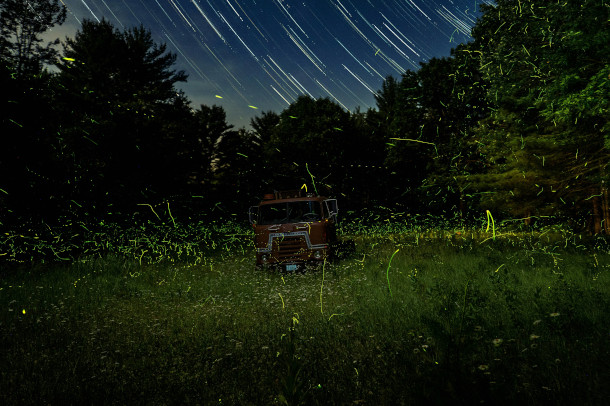
This timelapse, taken over the course of 30 minutes, shows fireflies in a Wisconsin field. (Photo: Robert Ritchie, Unsplash)
BELTRAN: It’s Living on Earth, I’m Paloma Beltran.
O’NEILL: I’m Aynsley O’Neill. It’s summer here in the States, and if you’re outside at night, you might be lucky enough to spot one of the most magical creatures that this season has to offer. We’re talking fireflies; they hold a really special place in many people’s hearts. For me, Paloma, I grew up seeing little lightning bugs in the yard every summer. How about you?
BELTRAN: You know Aynsley, not really, they’re not present in Mexicali due to its desert climate. But I did get a chance to catch them in the East Coast and in the state of Mexico. Should, though, hold on tight to these memories, because scientists say many fireflies are in decline. Living on Earth’s Ashanti Mclean has been looking into why their numbers are dropping and how we can protect them. She’s here with us now. Hey, Ashanti, how are you?
MCLEAN: Hey Paloma, I’m doing great. Just enjoying the rest of summer and excited to chat about some fireflies today!
O’NEILL: Okay, well, so first off, Ashanti, where can we find these creatures? You know, how wide-reaching are they?
MCLEAN: Yeah, they're really all over the states, and they can even reach up into Canada or down to Mexico, like Paloma mentioned. But you can really spot them the most in the eastern range of the US.
BELTRAN: And you know what’s really lovely about them is their glow. How do they make that happen?
MCLEAN: It’s pretty fascinating if you ask me. Some of the beetles produce light through a chemical reaction in their abdomens known as bioluminescence. And you can even see different colors and patterns based on things like species, temperature, or even the time of night that you spot them.
O’NEILL: And Ashanti, since we’re hearing that these bugs are in decline, just how serious is this problem?
MCLEAN: Well, there are over 100 firefly species in the U.S. alone, and roughly 2,000 around the world. But a recent study published by Science Direct reports a gradual drop among 18 species across North America.
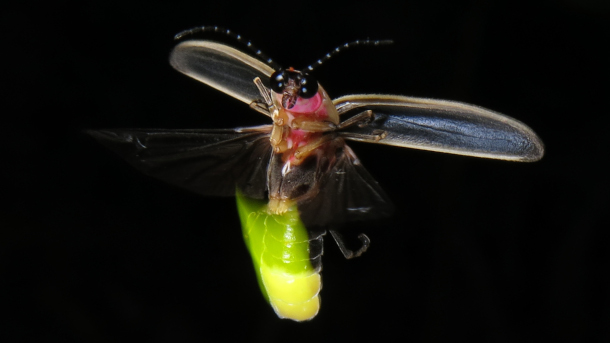
A close-up of a glowing firefly. (Photo: terry priest, Flickr, CC BY-SA 2.0)
O’NEILL: Oh, wow. That’s not nothing. I mean, just from personal experience, I feel like I see fewer and fewer fireflies as I get older.
MCLEAN: Well, I hate to admit I’ve seen pretty few so far, but summer’s not over yet, so I’m still crossing my fingers. And I actually learned that fireflies tend to be super localized, so sometimes one group may have lost its habitat, but you can still find others nearby. Ongoing environmental threats are what’s really putting these species at risk. Basically, residential and commercial development have degraded the very wetlands that they need most to thrive, not to mention climate change drying up that moisture as well.
BELTRAN: Yikes, and I’ve heard that the best thing for fireflies is actually to leave them alone, but what else can we do, Ashanti?
MCLEAN: Well, for starters, we have to keep in mind that protecting the habitat is a top priority. So it can help to do things like planting shrubs, leaving leaves behind after raking, and avoiding the use of pesticides. And yes, it’s better to keep fireflies as a light show rather than as a pet in a jar. So don’t forget to turn off your porch lights to get a better glimpse of their glow!
O’NEILL: Yes, very good point. Thank you for bringing us this report, Ashanti. It’s always good to get a little appreciation for these little lightning bugs.
BELTRAN: Yeah, and it’s good to know what we can do to help! Thanks, Ashanti.
MCLEAN: Thanks, Paloma. Thanks, Aynsley.
Related links:
- Yale E360 | “A Summer Light Show Dims: Why Are Fireflies Disappearing?”
- Grist | “Seeing Fewer Fireflies This Year? Here’s Why, and How You Can Help.”
- Read the study on firefly decline in Science Direct.
[MUSIC: JJ Grey & Mofro, J.J. Grey, “Fireflies” on Lochloosa, Fog City Records.]
Animal Self-Medication
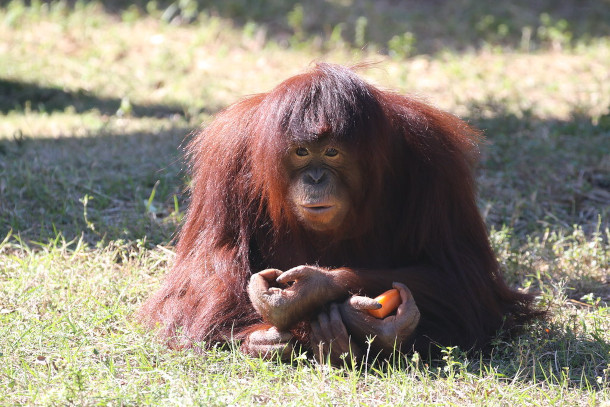
Sumatran orangutans are an endangered species native to Indonesia. (Photo: cuatrok77, Flickr, CC BY-NC-SA 2.0)
BELTRAN: Much of humanity’s medicine has its roots in the natural world around us. Think about aspirin, whose main ingredient can also be found in plants like willow and myrtle. Or for something a little stronger, opiates, which are synthesized from the flowers of the poppy plant. But humans aren’t the only creatures who have used plant medicine: zoologists have long seen behaviors of self-medicating in the animal kingdom. A paper published in the journal Scientific Reports describes the case study of an orangutan who healed his own wound. Rakus is a male, Sumatran orangutan living in Indonesia. After he sustained an injury to his face, Rakus chewed up some leaves of a woody vine called Akar Kuning. He then applied both the juice and the leaves of the plant to his injury. Within five days, the wound closed. Here to talk to us about this discovery is Michael Huffman, an ecologist who has spent his career studying the ways animals self-medicate. While he isn’t an author of the paper, he was one of the reviewers prior to publication. Michael Huffman, welcome to Living on Earth.
HUFFMAN: Thanks. Nice to be here.
BELTRAN: What makes this discovery new and exciting?
HUFFMAN: Well, it's the first detailed observation of an animal taking a plant and putting it onto a wound. And that wound apparently healed in a relatively good period of time. But the fact that the male put a plant with medicinal properties on a wound, very concertedly, it couldn't be mistaken as just an accident, is very interesting. There have been many reports, unpublished and unscientific, about this type of thing in other animal species. So, to have this detailed observation and have it published is very important, because it'll wake up scientists in the field to keep an eye on this kind of behavior, cause there are previous examples of something like this happening in other species, but we didn't have the details that this paper has provided.
BELTRAN: So, the plant that the orangutan named Rakus used to self-medicate is called Akar Kuning. What do we know about this plant?
HUFFMAN: The scientific name, the Latin name, is Fibraurea tinctoria. And it seems to be widely used in Asia, Southeast Asia, as medicine. It has anti-inflammatory properties. It has antimicrobial, probably antibiotic properties as well. And people use it widely. Another interesting thing, the researchers in this team and those from other groups who have been working at this site for a very long time, had never seen that behavior before. And Rakus, the male, came in from an outside population, as male orangutans do. They leave the group that they're born into, and they—they tend to travel around fairly solitarily and try and establish a territory, so he may be introducing a new behavior into this population that will allow these orangutan, if the behavior is transmitted to others, to treat wounds, which can be a serious problem, especially in the tropics—wounds are hard to heal, they tend to ulcerate and early treatment and keeping it clean is very important. Animals have an amazing way of healing themselves to begin with, they have a strong immune system. But as we know from other types of self-medication, they also need plants and things to help that process along.
BELTRAN: And from what I understand, primates are not the only animals who self-medicate. Tell us more about that.
HUFFMAN: To make a long story short, every animal on the planet self-medicates. We have observations and detailed studies from everything, including ants and bees, all the way up to humans, who also self-medicate. Before modern medicine, all the treatments were happening in the home. People were going out into the forest finding a plant that they had learned from their elders were effective in treating a number of different symptoms. So, every species of animal on the planet gets sick, are affected by parasites or microbes, or some other type of disease. We have accidents. We fall. We get cut. So, every species on the planet self-medicates.
BELTRAN: If such a broad range of species do this, then they probably have many different approaches. What are some other ways that animals self-medicate?
HUFFMAN: The patterns seem to be very similar across different species. Two of the modes that I have been working on in various different species, not all primates, is that in the normal diet, they include things that we would consider things like, spices, chilies, gingers, things like that. Onions even have antibacterial properties. So, they keep the food from spoiling, they keep down the microorganisms that can give us an upset stomach, for example. Another example that I found really, really interesting is called leaf swallowing. And plants have a self-defense mechanism to prevent animals from overeating their plant bodies. And so, they transfer toxic compounds to the leaves, or they'll set up barriers like very small hairs and things that are very hard to digest. And if an animal eats too many of these leaves, then it gets indigestion. So, they tend to avoid certain leaves of certain species because of those properties that the plant uses. But some animals have found a way to use that to their benefit, and they'll fold and swallow these leaves that are hard to digest. And what that does is reduces the time that it takes for food to pass through the system. And normally it's up to 24 hours, 30 hours, maybe, but what a number of different species, African great apes included, will do is fold and swallow leaves, reducing that transit time to six hours, and they're expelling the parasites in their intestinal tract. So, they have a physical means of purging themselves of parasites. So, it's a cool way of keeping the system clean. And we have examples of this in birds, in bears, in several primate species. It's really an interesting way of controlling parasites.
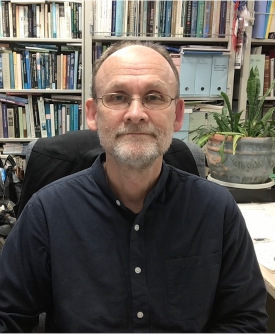
Dr. Michael Huffman has spent the majority of his career studying self-medication in animals. (Photo: Courtesy of Michael Huffman)
BELTRAN: Professor, you've spent most of your career studying this topic. What got you interested in the subject?
HUFFMAN: I first stumbled upon self-medication in animals following chimpanzees in Tanzania, in the Mahalia mountains. It was not my research topic, but I was always interested in medicinal plants and how traditional cultures around the world use those plants. And I had the good fortune of working with Mohamedi Seifu Kalunde. He was one of the staff in our research project that had been ongoing since 1965. And I started studying chimps in 1985. And I would often walk with him in the forest. And when we couldn't find the chimps, he would teach me about plants that his family had learned about and used to treat other people in the village. We worked together for probably close to 20 years. And it was the second year into my research there and working with him, that we came across a chimpanzee named Chausiku. She did something very interesting—I hadn't seen chimps eat a certain plant until that day, and it was Chausiku, who was doing it. And I asked Mohamedi, what's the name of the plant and he told me, it's Majonso. And I had never heard of that name. Tell me more about the plant. But I was interested in what—how she was going to eat it. So, I was just watching as Chausiku took this plant and she peeled off the bark, and started chewing on the pit. Very, very fresh, like celery. So, she was chewing, and then she sucked out the juice, but spit out everything else. Mohamedi breaks in and says, "Yeah, it's very, very bitter. I don't know why chimpanzees would want to eat this very bitter plant. We use it as medicine." And I began to remember that earlier that day, she wasn't well, and she climbed up a tree, built a nest, and went to sleep. But she left her young infant, Chopin just running around doing his thing. First thing that Chausiku did was to go to this plant Vernonia amygdalina. So, we were able to understand during the observations of two days, that she was very sick the first day, really not well the next morning, but by the next noon time, her behavior changed completely. Her appetite came back. Her strength came back. So just those two days was the beginning of a 35-year study on how animals self-medicate, and it continues today.
Nature is so cool! And we have no idea!
— 360 on History (@360onHistory) May 12, 2024
Rakus the orangutan patched a wound on his face up with a #medicinalplant - a first ever recorded instance of an animal self-medicating! #NatureIsAmazing #Intelligence #nature #animals #medicine https://t.co/OTnHv3g0Tg
BELTRAN: Although science has only somewhat recently acknowledged self-medicating animals, indigenous communities have known about this phenomenon for thousands of years. Can you talk a little bit about that?
HUFFMAN: As I mentioned before, with working with Mohamedi, we worked for about 20 years together, and it was only around the seventh, eighth or ninth year of our collaboration deep into studying animal self-medication in chimps that one day when the chimps were way, way up in the mountains, we were waiting for them to come down. And then he said, "I have a story for you about a plant that my grandfather discovered by watching a sick porcupine." And he went to tell me about how his—his grandfather, Babu Kalunde, discovered a very strong antibiotic by watching a porcupine dig up the roots and treat itself for bloody stools. And I said, "Well, that, that's amazing." And he says, "Yeah. And we have other examples." And I go, "What? You mean, your family and your tribe know that animals self-medicate? They've been aware of this for a long time?" "Oh, yeah, we have many examples like this." So, I got really interested, and I started looking at the literature from around the world. And it turns out that almost every society that I've been able to read about or talk with people from that culture, there is at least one plant that they have learned from animals.
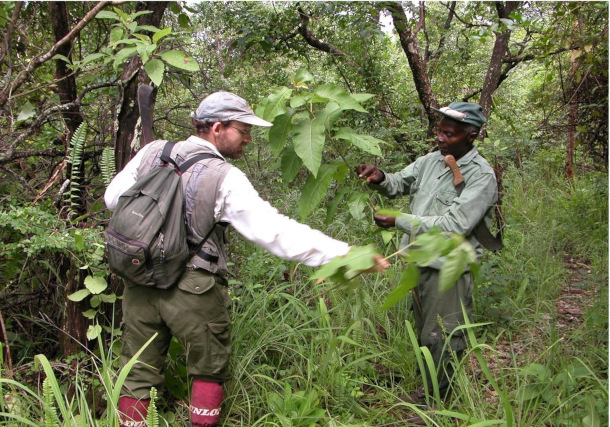
Dr. Huffman worked closely with Mohamedi Seifu Kalunde in Tanzania to learn more about the medicinal properties of native plants. (Photo: Courtesy of Michael Huffman)
BELTRAN: And what are your hopes for the future of this research?
HUFFMAN: Well, I hope more and more people will come on board and start looking carefully at their study subjects. Look at new species—we know very little about how animals in the ocean self-medicate. There's a lot of plants in the ocean that have toxic properties. Just like plants on land, they produce these things to protect themselves. But I'm sure that—that animals have also learned that those substances can be of benefit. So that may be one of our final frontiers, as it were, to go to the ocean and see how animals in the sea are dealing with diseases. But there's still so much on land in all the different habitats that animals live in that we really need to look at more. And I think in the end, the more we appreciate how animals exist in their environment, how they've acquired all of this knowledge, and how it's maintained within these different societies of animals, different cultures of animals, we'll come to appreciate them more and take better care of the planet. I don't know who said this, but it is so true: Nature doesn't need us. We need nature. So, I think we have to take better care of the nature around us and pay a little bit more respect to the animals who are living there.
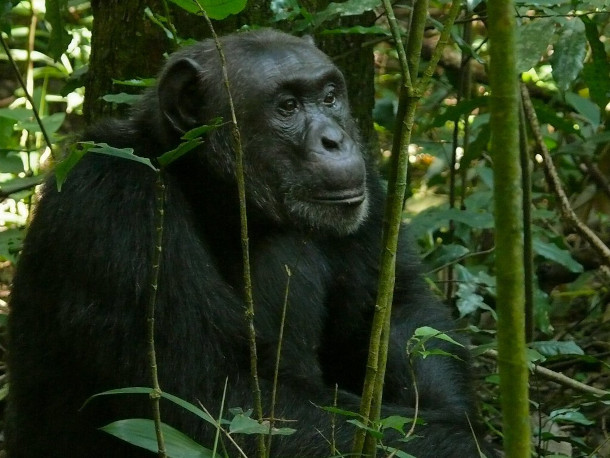
Although it is likely that many of the animal species on the planet self-medicate, scientists most often identify the behavior in primates, like chimpanzees. (Photo: Bernard Dupont, Flickr, CC BY-NC-SA 2.0)
BELTRAN: Dr. Michael Huffman is a visiting professor at the Institute of Tropical Medicine at Nagasaki University. Thank you for joining us.
HUFFMAN: Thank you.
Related links:
- Read the original study about Rakus
- Learn about Michael Huffman’s work with chimpanzees
[MUSIC: Jenny Owen Youngs, John Mark Nelson, “sunrise mtn” single, OFFAIR Records]
O’NEILL: Living on Earth is produced by the World Media Foundation. Our crew includes Naomi Arenberg, Jenni Doering, Daniela Faria, Swayam Gagneja, Mark Kausch, Mark Seth Lender, Don Lyman, Ashanti Mclean, Nana Mohammed, Sophia Pandelidis, Jake Rego, Andrew Skerritt, Bella Smith, Melba Torres, and El Wilson.
BELTRAN: Tom Tiger engineered our show. Alison Lirish Dean composed our themes. You can hear us anytime at loe.org, Apple Podcasts and YouTube Music, and like us please, on our Facebook page, Living on Earth. Find us on Instagram @LivingOnEarthRadio, and we always welcome your feedback at comments at loe.org. Steve Curwood is our Executive Producer. I’m Paloma Beltran
O’NEILL: And I’m Aynsley O’Neill. Thanks for listening!
ANNOUNCER: Funding for Living on Earth comes from you, our listeners, and from the University of Massachusetts, Boston, in association with its School for the Environment, developing the next generation of environmental leaders. And from the Grantham Foundation for the protection of the environment, supporting strategic communications and collaboration in solving the world’s most pressing environmental problems.
ANNOUNCER 2: PRX.
Living on Earth wants to hear from you!
Living on Earth
62 Calef Highway, Suite 212
Lee, NH 03861
Telephone: 617-287-4121
E-mail: comments@loe.org
Newsletter [Click here]
Donate to Living on Earth!
Living on Earth is an independent media program and relies entirely on contributions from listeners and institutions supporting public service. Please donate now to preserve an independent environmental voice.
NewsletterLiving on Earth offers a weekly delivery of the show's rundown to your mailbox. Sign up for our newsletter today!
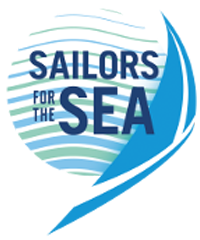 Sailors For The Sea: Be the change you want to sea.
Sailors For The Sea: Be the change you want to sea.
 The Grantham Foundation for the Protection of the Environment: Committed to protecting and improving the health of the global environment.
The Grantham Foundation for the Protection of the Environment: Committed to protecting and improving the health of the global environment.
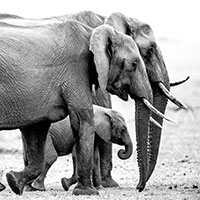 Contribute to Living on Earth and receive, as our gift to you, an archival print of one of Mark Seth Lender's extraordinary wildlife photographs. Follow the link to see Mark's current collection of photographs.
Contribute to Living on Earth and receive, as our gift to you, an archival print of one of Mark Seth Lender's extraordinary wildlife photographs. Follow the link to see Mark's current collection of photographs.
 Buy a signed copy of Mark Seth Lender's book Smeagull the Seagull & support Living on Earth
Buy a signed copy of Mark Seth Lender's book Smeagull the Seagull & support Living on Earth

